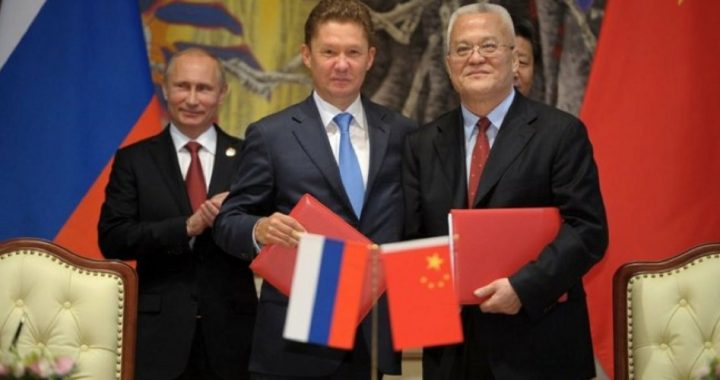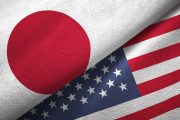
Although currently not a negotiating member of the Trans-Pacific Partnership (TPP), Russia may reap the benefits of TPP because of separate trade deals between various TPP member-states and the Eurasian Economic Union.
The TPP is a proposed “trade” pact negotiated among 12 Pacific Rim nations (Australia, Brunei, Canada, Chile, Japan, Malaysia, Mexico, New Zealand, Peru, Singapore, the United States, and Vietnam) representing 40 percent of global GDP. Earlier this month, U.S. Trade Representative Michael Froman announced that the United States and the 11 other participating Pacific Rim nations had reached a final agreement on the TPP.
The Eurasian Economic Union (EEU) is a regional economic trade bloc of five former Soviet states (Armenia, Belarus, Kazakhstan, Kyrgyzstan, and Russia) that is superficially modeled after the European Union (EU). Like the EU and its governing EU Commission in Brussels, the EEU’s permanent executive body is the Eurasian Economic Commission (EEC) based in Moscow. Despite its benign façade, the EEU is an attempt to gradually reestablish the Soviet Union in the form of a new totalitarian state.
And like the old Soviet Union, various Latin American nations, which are also a part of the TPP, have demonstrated “persistent interest” in cooperating with the Kremlin’s EEU, according to the director of the Russian Foreign Ministry’s Latin American Department, Alexander Shchetinin.
Sputnik News cited an interview with RIA Novosti (which until recently was Russia’s official international news agency), in which Shchetinin was quoted as saying, “The Latin American TPP participants show great and persistent interest in establishing constructive cooperation with the Eurasian Economic Union and its body — the Eurasian Economic Commission.” (Emphasis added.) “The interest of the Latin American Pacific Rim states in establishing concrete links with the Eurasian structures is obvious and we will certainly support and actively support it,” he added.
Outside of Latin America, other TPP members such as New Zealand and Communist Vietnam have made steps toward trade and economic integration with Moscow. Russian President Vladimir Putin (shown on left, as China and Russia sign a trade deal) welcomes the prospects of economic integration in the Pacific Rim.
Putin on TPP
In an interview with RT (Russia Today), published online on November 6, 2014, Vladimir Putin declared, “The role of APEC as an effective coordinating mechanism for building a new regional architecture is indispensable.”
APEC (Asia-Pacific Economic Cooperation) is an organization of 21 Pacific Rim nations — including Russia, China, Singapore, the United States, and the 11 other TPP members — dedicated to the advancement of regional economic integration through the utilization of what it calls “free trade.” APEC was established in Singapore in 1989, the same year the United States formally joined. Russia became a member in 1998.
APEC’s long-term project is the development of the Free Trade Area of the Asia-Pacific (FTAAP), a larger free trade agreement (FTA) than the TPP that would include all 21 APEC members. The governing Communist Party of China is one of the most vocal proponents of the FTAAP, which is also backed by the governments of Russia and the United States.
An official APEC press release posted on the White House website, dated November 13, 2010, states:
Based on the results of this work, we have agreed that now is the time for APEC to translate FTAAP from an aspirational to a more concrete vision. To that end, we instruct APEC to take concrete steps toward realization of an FTAAP, which is a major instrument to further APEC’s Regional Economic Integration (REI) agenda.
Not only does the U.S. government admit, as a leading APEC member, its support for the FTAAP, it goes even further, instructing “APEC to take concrete steps toward realization of an FTAAP.” The ruling political class of the United States wants the FTAAP every bit as much as Vladimir Putin and the Russian government. Here we also learn that the purpose of the TPP is to serve as a steppingstone for the FTAAP.
The press release states, “We believe that an FTAAP should be pursued as a comprehensive free trade agreement by developing and building on ongoing regional undertakings, such as ASEAN+3, ASEAN+6, and the Trans-Pacific Partnership, among others.” (Emphasis added.)
This intent is further corroborated by the Peterson Institute for International Economics (PIIE), a globalist think-tank founded by former Council on Foreign Relations (CFR) chairman Peter Peterson. On page three of the PIIE’s 2013 publication Understanding the Trans- Pacific Partnership is the statement,
The TPP is regarded as an interim arrangement or stepping stone toward a broader, regionwide Free Trade Area of the Asia Pacific (FTAAP), possibly within a decade, as envisaged by APEC leaders in Bogor in November 1994 and reaffirmed more recently by them in their meeting in Honolulu in November 2011.” [Emphasis added.]
During the RT interview, Putin was asked to “assess the prospects for APEC if the TPP is formed.” Demonstrating that he sees regional “trade” agreements as vehicles for larger global convergence, he replied, “Russia seeks to strengthen regional economic integration. Moreover, we also believe that free trade agreements should not fragment the multilateral trading system, but rather complement [it], contribute to its consolidation and the growth of interconnectedness.”
The Russian strongman observed of the TPP, “I believe that the absence of two major regional players such as Russia and China in its composition will not promote the establishment of effective trade and economic cooperation.” In other words, for the TPP to succeed, it must include both Russia and China.
Although not currently a member of the TPP, Putin’s Russia may reap the benefits of membership and circumvent current U.S. trade restrictions and sanctions by way of Russian trade agreements with other participating TPP nations.
New Zealand
On November 9, 2010, New Zealand, Russia, and its then-Eurasian Customs Union (EACU, precursor to the EEU) partners Belarus and Kazakhstan began negotiations on a “comprehensive and modern Free Trade Agreement (FTA),” according to the New Zealand Ministry of Foreign Affairs & Trade.
New Zealand Prime Minister John Key announced the negotiations on November 13, 2010, at the APEC summit in Yokohama, Japan, stating, “New Zealand is highly experienced in international trade negotiations, with a history of high quality FTAs, and is therefore an attractive partner for Russia.”
The first round of negotiations was scheduled for early 2011. On October 13, 2015, New Zealand First Party leader Winston Peters issued a press release advocating that his country restart negotiations on the FTA, which had been halted as a result of Russia’s military intervention in Ukraine and annexation of the Crimea in 2014. “With the risk of a new Cold War, are we benefitting politically or economically from our lack of meaningful engagement with Russia?” he asked.
Chile
On June 19, 2015, the Eurasian Economic Commission (EEC) and the government of Chile signed a “Memorandum of Understanding” in St. Petersburg, Russia.
The EEC reported on its official website,
The signing was held within the St. Petersburg International Economic Forum which was attended by the enlarged delegation of Chile consisting of the representatives of the government and business structures interested in establishment and development of trade and economic cooperation with the Member States of the Eurasian Economic Union (EAEU).
The memorandum of understanding aims at promoting development of economic cooperation of the EAEU States and the Republic of Chile.
The EEC-Chile memorandum of understanding proposed exchanges in regional economic integration and strategy of its development, economic cooperation, agricultural industry, financing, customs regulations, energy, intellectual property, services, technical regulations, transportation, and in additional areas of “mutual interest.”
The EEC referred to the signing of the memorandum as “the first step in developing systematic work of the [Eurasian Economic] Commission with the Latin American region.” Such “systematic work” may lead to a future free trade agreement between Chile and the Eurasian Economic Union.
Peru
On October 6, 2015, the EEC reported the signing of a similar memorandum of understanding with the government of Peru:
The memorandum proposes the establishment of a mechanism for consultation with the Peruvian Party. This would be a joint working group, within which there are plans to develop a dialogue on the practical issues of economic cooperation.” [Emphasis added.]
During a press conference following the signing of the EEC-Peru memorandum of understanding, EEC Minister for Development and Integration of Macroeconomics Tatyana Valovaya, who signed the memorandum on behalf of the EEC, stated, “Our main task is to facilitate growth of trade turnover between EAEU member states and Peru and to provide favourable conditions for direct cooperation in business circles.” (Emphasis added.)
Like the EEC-Chile memorandum of understanding, the EEC-Peru memorandum of understanding may be the first step toward a Peruvian FTA with the EEU.
Mexico
On June 16, 2014, Valovaya met with Mexican Ambassador to Russia Rubén Beltrán Guerrero.
“During the discussion,” the EEC reported, “Tatiana Valovaya described the main stages of the development of the Eurasian integration, and as well as highlighted in details the innovations related to the signing of the Treaty on the Eurasian Economic Union.”
Ambassador Beltrán spoke positively about investment cooperation regarding the construction of Mexican automotive parts manufacturer Nemak’s first plant in Russia, located in the Ulyanovsk region, which opened September 11, 2015.
Beltrán also noted in his discussion with Valovaya that Mexico was following the progress of Eurasian economic integration with keen interest. “Mexico is interested in increasing investment in the market of the three countries, as well as in increasing economic cooperation with the Eurasian Economic Union,” he asserted.
On October 19, 2015, Ambassador Beltrán again expressed Mexico’s strong interest in developing a greater economic relationship with the EEU. “We have a dialogue with [the Eurasian Economic] Commission. This is first stage, very first stage of the dialogue. I think that a possible relationship would be very desirable,” he stated.
Beltrán emphasized Mexico’s interest in the Russian energy sector, declaring, “A strategic alliance in the field of energy between Lukoil and Pemex, Rosneft and Pemex or Gazprom and Pemex would be essential for us.”
Gazprom, Lukoil, and Rosneft are the three largest natural oil and gas producers in Russia. Both Gazprom and Rosneft are SOEs (state-owned enterprises), while Lukoil is listed as a public-owned company; however, all three are managed by Kremlin insiders close to Vladimir Putin. Pemex is a Mexican SOE.
Beltrán also reassured his Russian counterparts that the Trans-Pacific Partnership is not a threat to Russia. “I do not believe this will have a negative impact on the commercial relations or the investments between Russia and Mexico,” he said, adding, “For Mexico the main impact that the TPP will have is to give us greater access to other markets.”
In addition to the TPP, Mexico already has separate FTAs with Peru, Chile, the European Union, and both the United States and Canada via the North American Free Trade Agreement (NAFTA). It is only a mater of time before Mexico has its own FTA with Russia and the EEU.
Vietnam
On May 29, 2015, the Socialist Republic of Vietnam signed an FTA with the EEU. Vietnamese Prime Minister Nguyen Tan Dunghave and Russian Prime Minister Dmitry Medvedev signed the agreement in Vietnam, along with their Armenian, Belarusian, Kazakh, and Kyrgyzstani counterparts.
“A historic act took place today,” Eurasian Economic Commission board chairman Viktor Khristenko announced after the six ministers signed the agreement. Medvedev stated,
Around 40 states have opted for holding talks on concluding this kind of agreements on a free trade zone with EEU, and of course we will be thinking this through as carefully as possible, so that those agreements are useful to our countries.
Earlier that month, on May 5, 2015, Vietnam signed an FTA with the Republic of Korea (South Korea), which already has an FTA with the United States. President George W. Bush and South Korean President Roh Moo-hyun signed the United States-Korea Free Trade Agreement (KORUS FTA) on June 30, 2007, and it was approved by Congress on October 12, 2011.
The day Congress ratified the agreement, Senator Bernie Sanders (I-Vt.) warned that the KORUS FTA would create backdoor free trade with North Korea, declaring:
Mr. President, let me touch on one particular aspect of the Korea Free Trade Agreement that I find especially troubling. And that is that this particular Free Trade Agreement will force American workers to compete against workers in North Korea the most undemocratic country in the world and will financially benefit the communist dictatorship of Kim Jong Il. [Emphasis added.]
But, if the South Korean Free Trade agreement is signed into law, the United States would have a new obligation to allow South Korean products to come into our country tariff-free that contain major parts made by North Korean workers who make pennies an hour.
Today, over 47,000 North Korean workers are currently employed by more than 120 South Korean firms, including Hyundai, at the Kaesong Industrial Complex located just six miles north of the demilitarized zone [in North Korea].
There is a loophole in this trade agreement that allows products and parts from North Korea to be shipped to South Korea and then sent to the United States tariff free or virtually tariff free. And, that is what I am concerned about.
Just as there exists an apparent “loophole” in the KORUS FTA allowing for North Korean products and parts to be shipped to South Korea, where they can in turn make their way into the United States, likewise the same would be true of Russia via any one of the TPP member-states, such as New Zealand, Vietnam, Chile, Peru, and Mexico, that have separate FTAs with either Russia or the Eurasian Economic Union. Even without the United States being a TPP member, its goods directly restricted to Russia could enter via one of the aforementioned TPP members and the opposite would also be true of Russian-made products entering the United States.
Whether through the long-term development of APEC’s proposed FTAAP, or through separate FTAs with individual TPP member-states, or even through a formal invitation for official TPP membership, Russia will for all practical purposes have almost unrestricted free trade with the United States, Australia, and other countries in the TPP. Despite any claims to the contrary, the TPP will not contain or curb Russia’s economic influence.
Related articles:
China Seeks to Join Trans-Pacific Partnership (TPP)
Trans-Pacific Partnership To Facilitate U.S.-China Merger
Putin’s East vs. Globalist West: Merging Into a New World Order
Putin & Xi Stress Beijing-Moscow Ties at APEC




